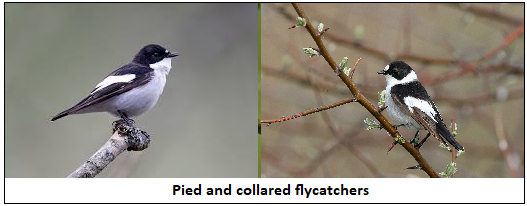The songbird has been found to learn best the songs of its own kind, says S.Ananthanarayanan.
The songbird is unique among animals in the capacity of its voice-box and its ability to repeat sequences of tones that follow patterns. The study of how this comes about could help us understand how the human baby learns to speak, both in its parental dialect as well as another language.
Studies have shown that birdsong is not innate, but is learnt by the fledgling, usually from its father. Birds, do, however, learn to produce or to respond to songs of closely related species of birds. David Wheatcroft and Anna Qvarnström, of the department of Ecology and Genetics, Uppsala University, Sweden, describe in the journal, Nature Ecology and Evolution, a study that shows that genetics plays a major role in the final repertoire or musical preference of the feathered singer.

Humans are capable of speech, oral and musical communication because of the apparatus in the voice-box and the mobility of the oral cavity, on one part, and the intelligence to connect sounds with meaning and grammatical structure, on the other. Even with these prerequisites, however, just how languages evolve and why most languages have similarity in structures has not been understood.
Many birds have a voice-box structure called the syrinx, the equivalent of the human larynx, that is placed deep within the birds’ throat, with the capacity to produce more than one tone at a time. Birds make good use of this organ for endless chatter, individually, in pairs or in groups, and can belt out a clutch of different tones in long sequences. Studies have shown that the sequences are not random and each species of bird uses specific patterns for aspects of communication. Messages passed could be mating calls, aggression, keeping the flock together, encouraging the young to feed and so on. Young birds learn while still in the nest from adult ‘tutors’, usually the male parent. There is also evidence that birds can again be trained to produce different tone sequences by a trainer bird, or even a recording, over a few days.
While conveying information would be one function of birdsong ability, another is its role in species identity. The birdsong the fledgling hears just before hatching and while in the nest would be the language the bird will later chirp or recognise. This would then help the bird find a mate or be found as a mate, to keep the genetic line within the species. There are, however, instances of ‘song mixing’ and confusing of mating calls of closely related species, which may be a result of ‘cross learning’. The Uppsala University researchers hence examined whether social experience was indeed the ‘main determinant of early song discrimination’. Many other factors interplay, the paper says, like the maternal effect of deposition of the hormone, testosterone in the yolk, which could affect the development of the brain cells that are involved in song discrimination. And then, the genetic background could be a factor.
The researchers hence tested for the relative effect of the different factors by assessing the song discrimination in nestlings that had been blocked out from sounds made by the same species even while in the embryo, in the egg, or exposed to the songs of related species and in birds that were of mixed genetic heritage, by a cross of closely related species. The collared flycatcher and the pied flycatcher are two closely related songbirds that are found in the Baltic island of Öland. The songs of the two species have different characteristic features, the paper says, and these differences serve to regulate mating patterns. Nevertheless, about 6% of the pairs the birds form have one adult of each species. Both species are believed to learn songs from what they hear and it is possible that a nestling is affected by the songs of a nearby distant relative!

Among the Baltic flycatchers, the paper says, fledglings learn to make out the songs of their species by the ninth day after hatching. And then, the hearing apparatus in the embryo develops just before hatching. Using this information, the researchers could manipulate the whole early hearing experience of fledglings by swapping the eggs in the nests of the two species. A pied flycatcher was hence hatched and raised by collared flycatchers and a collared flycatcher was hatched and raised by pied flycatchers. “If song discrimination depends on early acoustic experience, we pre¬dict that nestlings should express stronger responses to playbacks of their social parents’ songs regardless of species identity,” the paper says.
The other trial was with cross-bred, or hybrid flycatchers. Birds in aviaries were mated and there was a set of young ones, male and female, with a pied father and collared mother or a collared father and a pied mother. Trials with the song discrimination preferences could then assess the effect of maternal genes and sex-linked inheritance. “Taken together, these two approaches allowed us to disentangle the effects of experience from social parents, maternal effects from the maternal species and genetic background from both parental species,” the paper says.
A powerful indicator of recognition of the parent is the start of begging calls, or cries for food, on the part of young birds. The trials showed that nestlings raised by parents of the same species responded with more begging calls on hearing parents’ songs. These nestlings were also more likely to respond with ‘looking up’ and ‘shifting position’, which were other responses, when they heard same species songs. The other significant finding was that even nestlings raised, since the embryonic state, by parents of another species, still showed preference for calls of their real species. This finding is a strong indicator that song discrimination is not experience dependent. A surprising, further finding was that this class of nestlings showed stronger response to same species songs than nestling that had been raised by parents of the same species!
The next question to test was whether it was the species of the mother that had the strongest effect on the songs to which the young would respond most strongly. If this were so, both pure bred, but foster-raised nestlings as well as hybrid nestlings should respond to songs of the biological mother’s species in the same way as pure bred birds raised by parents of the same species. The results, however, pointed to another way - hybrid nestlings responded more strongly to pied flycatcher calls irrespective of the species of the biological mother. There was even evidence that hybrids with collared mothers responded more strongly to pied flycatcher songs than hybrids with pied mothers!
The evidence hence rules out experience or maternal effects as main factors that influence the response of young birds to songs of either species. The implication is that it is genetics that has the strongest effect. A genetic predisposition to prefer same species songs is thus the built-in safeguard to maintain species-specific mating calls and reduce instances or the effects of learning songs of related species.
Why it happens, in a few cases, nevertheless, and more males learn other-species songs, would be related to male-male competition and control of territory, the paper says. The main factor that “tunes avian auditory systems to be most sen¬sitive to conspecific vocalizations,” however, would appear to lie in the genetic, and hence species-specific heritage, the paper says.
------------------------------------------------------------------------------------------